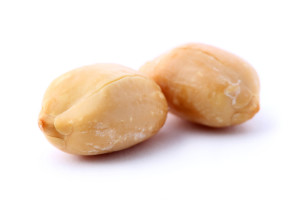 Tripp Underwood contributed to this post.
Tripp Underwood contributed to this post.
Families with peanut-allergic children live in fear that their child will ingest peanuts—even minute amounts—accidentally. Now, a small pilot study published in the Journal of Allergy and Clinical Immunology offers hope.
In the year-long study, immunologist Dale Umetsu, MD, PhD, and colleagues in the Division of Allergy and Immunology at Boston Children’s Hospital were able to get some children to tolerate as many as 20 peanuts at a time. Their protocol combines a powerful anti-allergy medication with a methodical desensitization process.
While it’s not a cure, the protocol may enable children to weather trace amounts of peanuts that might lurk in baked goods or foods “manufactured in a facility that processes peanuts.” Even a small amount of peanut tolerance could be lifesaving.
An unexplained rise
Peanut allergies were once fairly uncommon. Today, they affect millions of children: One recent study shows reported peanut allergies tripling in just over a decade. The allergic reactions are particularly life-threatening—80 to 95 percent of all food allergy deaths are peanut or tree nut related. It’s the extreme of the widespread, still unexplained rise in allergies.
“The first wave, 25 years ago, was asthma increasing about two-fold,” says immunologist Dale Umetsu, MD, PhD. “That’s when kids began bringing their albuterol inhalers to school. Then, 10 to 12 years ago, the second wave began. Now kids have to bring their Epi-Pens to school.”
 Desensitization has been widely studied for the past few years as a treatment for food allergies. The person is exposed to a very small amount of his or her allergy trigger—usually not enough to cause a reaction—in a controlled medical environment. The dosage is then increased by small amounts over time, the idea being that the person can begin to tolerate the trigger food.
Desensitization has been widely studied for the past few years as a treatment for food allergies. The person is exposed to a very small amount of his or her allergy trigger—usually not enough to cause a reaction—in a controlled medical environment. The dosage is then increased by small amounts over time, the idea being that the person can begin to tolerate the trigger food.
By itself, food desensitization takes a long time and is fraught with frequent allergic reactions, some of them severe. As many as 30 percent of patients with peanut allergies simply cannot complete the process.
Several years ago, treating a group of patients with severe milk allergies, Umetsu and Lynda Schneider, MD, successfully enhanced desensitization by adding omalizumab (Xolair®), a drug approved by the FDA to treat allergic asthma. Omalizumab attaches itself to the IgE antibodies that the immune system churns out when confronted with a trigger food, preventing them from sparking an allergic reaction.
One peanut at a time
In a year-long study, Umetsu and colleagues took the same approach in 13 patients with severe peanut allergies. For the first 12 weeks, the children were pretreated with omalizumab—receiving monthly or bi-monthly injections in the clinic. They then embarked on peanut desensitization.
To begin, each child received just one-tenth of a milligram of ground-up peanut—a very small fraction of a single nut. Every 30 minutes, the dosage was increased by small amounts under close medical observation. At the end of six hours, each child had eaten about two and a half peanuts without developing anything more than a mild itch. “That’s faster than any other protocol,” says Umetsu.
 To appreciate what this means, consider that previously, as little as one-quarter of one peanut would have likely caused allergic reactions in all these children. “The two-peanut milestone would be enough to protect them from a trace exposure,” says Umetsu. “That alone is encouraging.”
To appreciate what this means, consider that previously, as little as one-quarter of one peanut would have likely caused allergic reactions in all these children. “The two-peanut milestone would be enough to protect them from a trace exposure,” says Umetsu. “That alone is encouraging.”
For the next eight weeks, the children continued to receive omalizumab under observation and to ingest increasingly larger numbers of peanuts. By the end, they were consuming about 10 peanuts a day with zero to very mild reactions. The omalizumab injections were then stopped, but the children continued to take daily peanuts for the remainder of the year.
Bumps in the road
The researchers recorded 72 reactions during the course of the study, mostly from the ingested peanuts (25 reactions occurred in a single patient, thought to be related to a heart arrhythmia). Most reactions were mild, consisting of nausea and excessive salivation, and easily treated as needed with an antihistamine. There were three anaphylactic reactions that required epinephrine followed by observation in the Emergency Department, and one child left the study during week 15 because of persistent nausea and vomiting.
But by the end of the year, 12 of the 13 children were able to consume up to 20 peanuts a day without receiving any additional medication.
“We worked against ourselves by enrolling only significantly peanut-allergic patients,” says Umetsu. “We deliberately tried to enroll kids who weren’t outgrowing their allergy.”
Because this protocol is a treatment and not a cure, the children’s immune systems are still producing the IgE antibodies that cause their allergies, albeit in much lower amounts, Umetsu notes. To keep these antibodies at safe levels, the children will need to eat peanuts daily so their bodies remain “used to them.” As they do so, Umetsu predicts their peanut-specific IgE antibody levels will continue to go down.
Next steps
Not all kids are eager for their prescribed peanut M&Ms and Reeses. “Disliking the taste of peanuts is a real issue for some of our patients,” says study co-author Rima Rachid, MD, “so we’re working with them to provide their daily peanut intake in different ways, like baking peanut flour in cookies, or using it in pill capsules so it can be swallowed whole.”
Excited by their pilot findings, Umetsu, Schneider and Rachid have launched a multi-center clinical trial of the protocol, known as PRROTECT, which includes a placebo-controlled arm. (For enrollment information, contact [email protected].)
Xolair is expensive (it’s a monoclonal antibody, so it requires special bio-manufacturing) and is not FDA-approved for food allergy. And, insurance companies don’t reimburse for it. But Umetsu and colleagues hope the new study will confirm their findings and convince others to try it.
In the meantime, the researchers are not stopping at peanuts. “Now that we’ve completed peanuts, we can go to different foods and multiple foods together,” Umetsu says.
Acknowledgments: The Thrasher Research Foundation, the Clinical and Translational Science Center/Harvard Catalyst (NIH UL1 RR 025758), the Food Allergy Initiative, the Bunning Food Allergy Project, the Jasmine and Paul Mashikian Fund and Genentech funded the study. Boston Children’s Clinical Research Center provided biostatistical support through Drs. Emily Blood and Les Kalish, and project management support by Hana Gragg. After the study concluded, Umetsu accepted the position of principal medical director at Genentech, the biotechnology company that developed Xolair. Boston Children’s Hospital and Umetsu received funding from the company at the time of the research.







